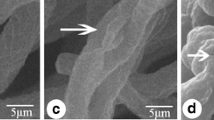Abstract
The present study investigated the antifungal activity of octanal against Penicillium italicum and P. digitatum. Results showed that octanal exhibited strong antifungal activity against the test pathogens in a dose-dependent manner. Scanning electron microscopy observation revealed that octanal obviously altered the morphology of P. italicum and P. digitatum hyphae by causing the loss of cytoplasm and distortion of mycelia. A rapid increase in the membrane permeability of P. italicum and P. digitatum was observed after treated with octanal at minimum inhibitory concentration or minimum fungicidal concentration, evidenced by the release of cell constituents, the extracellular conductivity and the extracellular potential of hydrogen. In addition, octanal apparently induced a decrease in total lipid contents of P. italicum and P. digitatum cells. These results suggested that the antifungal activity of octanal against P. italicum and P. digitatum can be attributed to the disruption of the cell membrane integrity and the leakage of cell components.




Similar content being viewed by others
References
Askarne L, Talibi I, Boubaker H, Boudyach EH, Msanda F, Saadi B, Ait Ben Aoumar A (2012) Use of Moroccan medicinal plant extracts as botanical fungicide against citrus blue mould. Lett Appl Microbiol 56:37–43
Ballester AR, Izquierdo A, Lafuente MT, González-Candelas L (2010) Biochemical and molecular characterization of induced resistance against Penicillium digitatum in citrus fruit. Postharvest Biol Technol 56:31–310688
Caccioni DRL, Guizzardi M, Biondi DM, Renda A, Ruberto G (1998) Relationship between volatile components of citrus fruit essential oils and antimicrobial action on Penicillium digitatum and Penicillium italicum. Int J Food Microbiol 43:73–79
Cañamás TP, Viñas I, Usall J, Torres R, Anguera M, Teixidó N (2008) Control of postharvest diseases on citrus fruit by preharvest applications of biocontrol agent Pantoea agglomerans CPA-2: part II. Effectiveness of different cell formulations. Postharvest Biol Technol 49:96–106
Droby S, Eick A, Macarisin D, Cohen L, Rafael G, Stange R, McColum G, Dudau N, Nasser A, Wisniewski M, Shapira R (2008) Role of citrus volatiles in host recognition, germination and growth of Penicillium digitatum and Penicillium italicum. Postharvest Biol Technol 49:386–396
du Plooy W, Regnier T, Combrinck S (2009) Essential oil amended coatings as alternatives to synthetic fungicides in citrus postharvest management. Postharvest Biol Technol 53:117–122
Fisher K, Phillips C (2008) Potential antimicrobial uses of essential oils in food: is citrus the answer? Trends Food Sci Technol 19:156–164
González-Candelas L, Alamar S, Sánchez-Torres P, Zacarías L, Marcos JF (2010) A transcriptomic approach highlights induction of secondary metabolism in citrus fruit in response to Penicillium digitatum infection. BMC Plant Biol 10:194–211
Gross RW, Han XL (2011) Lipidomics at the interface of structure and function in systems biology. Chem Biol 18:284–291
Heaton NS, Randall G (2011) Multifaceted roles for lipids in viral infection. Trends Microbiol 19:368–375
Helal GA, Sarhan MM, Abu SANK, Abou EEK (2007) Effects of Cymbopogon citratus L. essential oil on the growth, morphogenesis and aflatoxin production of Aspergillus flavus ML2-strain. J Basic Microbiol 47:5–15
Liu J, Zong YY, Qin GZ, Li BQ, Tian SP (2010) Plasma membrane damage contributes to antifungal activity of silicon against Penicillium digitatum. Curr Microbiol 61:274–279
Marquis RE, Clock SA, Mota-Meira M (2003) Fluoride and organic weak acids as modulators of microbial physiology. FEMS Microbiol Rev 26:493–510
Montesinos-Herrero C, Smilanick JL, Tebbets JS, Walse S, Palou L (2011) Control of citrus postharvest decay by ammonia gas fumigation and its influence on the efficacy of the fungicide imazalil. Postharvest Biol Technol 59:85–93
Oonmetta-aree J, Suzuki T, Gasaluck P, Eumkebc G (2006) Antimicrobial properties and action of galangal (Alpinia galanga Linn.) on Staphylococcus aureus. LWT-Food Sci Technol 39:1214–1220
Paul S, Dubey RC, Maheswari DK, Kang SC (2011) Trachyspermum ammi (L.) fruit essential oil influencing on membrane permeability and surface characteristics in inhibiting food-borne pathogens. Food Control 22:725–731
Raybaudi-Massilis RM, Mosqueda-Melgar J, Martin-Belloso O (2006) Antimicrobial activity of essential oils on Salmonella enteritidis, Escherichia coli, and Listeria innocua in fruit juices. J Food Prot 69:1579–1586
Scora KM, Scora RW (1998) Effect of volatiles on mycelium growth of Penicillium digitatum, P. italicum, and P. ulaiense. J Basic Microbiol 38:405–413
Sharma N, Tripathi A (2006) Fungitoxicity of the essential oil of Citrus sinensis on post-harvest pathogens. World J Microbiol Biotechnol 22:587–593
Sharma N, Tripathi A (2008) Effects of Citrus sinensis (L.) Osbeck epicarp essential oil on growth and morphogenesis of Aspergillus niger (L.) Van Tieghem. Microbiol Res 163:337–344
Talibi I, Askarne L, Boubaker H, Boudyach EH, Msanda F, Saadi B, Ait Ben Aoumar A (2012) Antifungal activity of some Moroccan plants against Geotrichum candidum, the causal agent of postharvest citrus sour rot. Crop Prot 35:41–46
Turgis M, Han J, Caillet S, Lacroix M (2009) Antimicrobial activity of mustard essential oil against Escherichia coli O157:H7 and Salmonella typhi. Food Control 20:1073–1079
Viuda-Martos M, Ruiz-Navajas Y, Fernández-López J, Pérez-Álvarez J (2008) Antifungal activity of lemon (Citrus lemon L.), mandarin (Citrus reticulata L.), grapefruit (Citrus paradisi L.) and orange (Citrus sinensis L.) essential oils. Food Control 19:1130–1138
Watkins EB, Miller CE, Majewski J, Kuhla TL (2011) Membrane texture induced by specific protein binding and receptor clustering: active roles for lipids in cellular function. Proc Natl Acad Sci USA 108:6975–6980
Yahyazadeh M, Omidbaigi R, Zare R, Taheri H (2008) Effect of some essential oils on mycelial growth of Penicillium digitatum Sacc. World J Microbiol Biotechnol 24:1445–1450
Acknowledgments
This work was supported by National Natural Science Foundation of China (No. 31271964), Research Foundation of Education Bureau of Hunan Province (No.12B126) and National University Student Innovation Programs of China (No. 201210530012).
Author information
Authors and Affiliations
Corresponding author
Rights and permissions
About this article
Cite this article
Tao, N., Jia, L., Zhou, H. et al. Effect of octanal on the mycelial growth of Penicillium italicum and P. digitatum . World J Microbiol Biotechnol 30, 1169–1175 (2014). https://doi.org/10.1007/s11274-013-1539-2
Received:
Accepted:
Published:
Issue Date:
DOI: https://doi.org/10.1007/s11274-013-1539-2




